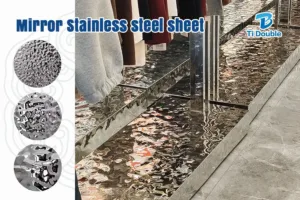Stainless steel sheets are indispensable in numerous industries, from construction and automotive to home appliances and kitchenware. Their unmatched durability, corrosion resistance, and sleek appearance make them a popular choice for a wide range of applications. If you’re considering using stainless steel sheets, this guide will walk you through their types, uses, benefits, and how to choose the best one for your needs.
Table of Contents
- 1. What is a Stainless Steel Sheet?
- 2. Common Types of Stainless Steel Sheets
- 3. Popular Applications
- 4. Key Advantages of Stainless Steel Sheets
- 5. Different Finishes of Stainless Steel Sheets
- 6. Things to Consider When Choosing Stainless Steel Sheets
- 7. Maintenance Tips for Stainless Steel Sheets
- 8. Frequently Asked Questions
1. What is a Stainless Steel Sheet?
A stainless steel sheet is a flat piece of stainless steel that comes in various thicknesses and sizes, used in a wide array of industries. What sets stainless steel apart is its chromium content, which forms a protective layer on the surface and gives the material its unique rust and corrosion-resistant properties.
These sheets are incredibly versatile, ranging from industrial uses like machinery components to decorative features in modern architecture. The addition of metals like nickel and molybdenum to the steel mixture can further enhance qualities like heat resistance or structural strength, making stainless steel sheets one of the most reliable materials on the market.

2. Common Types of Stainless Steel Sheets
There are several grades of stainless steel, each offering specific advantages depending on your needs. Below are the most popular types used in the UK.
2.1 304 Stainless Steel
304 stainless steel is the most widely used variety due to its excellent resistance to corrosion, strength, and affordability. This grade works well in general environments, making it perfect for kitchen equipment, food processing, and construction projects.
2.2 316 Stainless Steel
316 stainless steel contains more nickel and adds molybdenum, making it more resistant to corrosion, especially in harsh environments like saltwater or industrial areas. This grade is ideal for marine applications, chemical plants, and coastal building projects where higher corrosion resistance is necessary.
2.3 430 Stainless Steel
430 stainless steel is a more budget-friendly option, used in situations where corrosion resistance is not as crucial. It is common in interior decorative applications, such as trims, and for household appliances. While it doesn’t have the corrosion resistance of 304 or 316, its appearance and lower cost make it popular for non-critical uses.
3. Popular Applications
Stainless steel sheets are used across a variety of sectors due to their durability, appearance, and versatility. Here are the most common applications:
3.1 Construction & Architecture
In the UK, stainless steel sheets are often used for architectural facades, cladding, and roofing. These sheets offer not only a sleek, modern appearance but also high durability, weather resistance, and low maintenance. Architects also use them to create decorative features that complement modern design trends, providing an aesthetic yet functional building material.
3.2 Automotive Industry
In the automotive industry, stainless steel sheets are favoured for their strength and ability to withstand extreme conditions. They’re used for components like exhaust systems, trim details, and even structural parts of the vehicle. Stainless steel’s high resistance to rust and temperature fluctuations makes it a key material in car manufacturing.
3.3 Kitchen Equipment & Appliances
Stainless steel is synonymous with kitchens—whether in home kitchens or commercial settings. Its smooth, non-porous surface makes it hygienic and easy to clean, which is crucial in food preparation environments. Stainless steel sheets are commonly used for countertops, sinks, backsplashes, and appliances, thanks to their heat resistance, strength, and sleek, modern look.

4. Key Advantages of Stainless Steel Sheets
Stainless steel sheets offer a range of benefits that make them a top choice in various industries:
- Corrosion Resistance: One of the most valuable properties of stainless steel is its ability to resist rust and corrosion, particularly in wet or humid conditions.
- Durability: These sheets are incredibly strong, able to withstand high impact, pressure, and temperature fluctuations, making them perfect for both indoor and outdoor use.
- Low Maintenance: Stainless steel is easy to clean and maintain. A simple wipe-down with a soft cloth can remove most marks, and it resists stains and fingerprints, especially with a brushed or matte finish.
- Aesthetic Appeal: Stainless steel has a clean, sleek appearance that works well in modern architecture, interior design, and appliances.
- Hygienic Properties: Stainless steel is non-reactive and easy to sterilise, making it a top material for food preparation areas, hospitals, and laboratories.
5. Different Finishes of Stainless Steel Sheets
The finish of a stainless steel sheet not only affects its appearance but also its function. Here are the most common finishes available:
5.1 Brushed Finish
A brushed finish is achieved by polishing the steel with fine grit, resulting in a satin-like texture. The fine lines in the surface give it a less reflective quality than other finishes, making it ideal for areas where glare might be a problem, such as kitchen appliances or architectural elements.
5.2 Mirror Finish
Mirror-finished stainless steel is highly polished to create a reflective surface. This finish is commonly used in decorative or design-driven applications, such as feature walls, modern furnishings, and elevators. The reflective nature also enhances the perception of space in interior settings.
5.3 Matte Finish
Matte-finished stainless steel sheets have a non-reflective surface, making them ideal for industrial environments or where appearance isn’t as important as function. It’s frequently used in kitchens, laboratories, or other settings where a low-maintenance, easy-to-clean surface is required.
6. Things to Consider When Choosing Stainless Steel Sheets
When choosing stainless steel sheets, it’s important to consider the following factors:
- Grade: Depending on the environment and required durability, select the appropriate grade. For instance, if your project involves exposure to salty air or corrosive substances, 316 stainless steel would be the best choice.
- Thickness: Stainless steel sheets come in various thicknesses. Thicker sheets provide greater durability and strength, while thinner sheets are easier to shape and cut.
- Finish: The finish not only affects the visual appearance but also the sheet’s performance in terms of fingerprint resistance, reflectivity, and ease of cleaning.
- Cost: While higher grades like 316 provide better performance, they also come at a higher cost. Assess the specific requirements of your project before deciding on the grade and thickness.

7. Maintenance Tips for Stainless Steel Sheets
Stainless steel sheets are known for their low maintenance, but regular care can help keep them looking their best:
- Cleaning: Regularly clean the surface with warm water and a soft cloth to remove smudges and fingerprints. For tougher stains, use a mild detergent or a specialised stainless steel cleaner.
- Avoid Harsh Chemicals: Avoid using abrasive cleaning tools or harsh chemicals like bleach, as they can damage the surface.
- Polishing: For mirror finishes, use a soft cloth and non-abrasive polish to maintain the sheet’s reflective quality.
8. Frequently Asked Questions
What is the most common type of stainless steel sheet?
The most common type is 304 stainless steel, thanks to its affordability, corrosion resistance, and versatility.
Can stainless steel sheets be used outdoors?
Yes, 316 stainless steel is especially well-suited for outdoor environments due to its superior corrosion resistance, even in salty or industrial conditions.
How thick should my stainless steel sheet be?
The thickness depends on your application. Thinner sheets (1-2mm) are often used for decorative purposes, while thicker sheets (3-5mm) are used in construction or heavy-duty applications.
Is stainless steel environmentally friendly?
Yes, stainless steel is 100% recyclable and often made from recycled materials, making it an environmentally sustainable choice.
How do I cut stainless steel sheets?
Stainless steel sheets can be cut using tools like metal shears, plasma cutters, or even lasers for more precise cuts. For DIY projects, you might need professional help to ensure clean edges.



